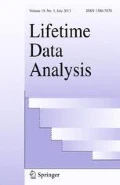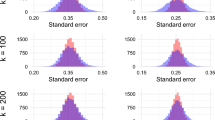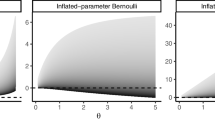Abstract
Panel count data commonly arise in epidemiological, social science, and medical studies, in which subjects have repeated measurements on the recurrent events of interest at different observation times. Since the subjects are not under continuous monitoring, the exact times of those recurrent events are not observed but the counts of such events within the adjacent observation times are known. A Bayesian semiparametric approach is proposed for analyzing panel count data under the proportional mean model. Specifically, a nonhomogeneous Poisson process is assumed to model the panel count response over time, and the baseline mean function is approximated by monotone I-splines of Ramsay (Stat Sci 3:425–461, 1988). Our approach allows to estimate the regression parameters and the baseline mean function jointly. The proposed Gibbs sampler is computationally efficient and easy to implement because all of the full conditional distributions either have closed form or are log-concave. Extensive simulations are conducted to evaluate the proposed method and to compare with two other bench methods. The proposed approach is also illustrated by an application to a famous bladder tumor data set (Byar, in: Pavone-Macaluso M, Smith PH, Edsmyn F (eds) Bladder tumors and other topics in urological oncology. Plenum, New York, 1980).





Similar content being viewed by others
References
Balshaw RF, Dean CB (2002) A semiparametric model for the analysis of recurrent-event panel data. Biometrics 58:324–331
Byar DP (1980) The veterans administration study of chemoprophylaxis for recurrent stage I bladder tumors: comparisons of placebo, pyridoxine, and topical thiotepa. In: Pavone-Macaluso M, Smith PH, Edsmyn F (eds) Bladder tumors and other topics in urological oncology. Plenum, New York, pp 363–370
Cai B, Lin X, Wang L (2011) Bayesian proportional hazards model for current status data with monotone splines. Comput Stat Data Anal 55:2644–2651
Chib S, Greenbergb E, Winkelmann R (1998) Posterior simulation and Bayes factors in panel count data models. J Econom 86:33–54
Gelfand AE, Smith AFM (1990) Sampling-based approaches to calculating marginal densities. J Am Stat Assoc 85:398–409
Geman S, Geman D (1984) Stochastic relaxiation, Gibbs distributions, and the Bayesian restoration of images. IEEE Trans Pattern Anal Mach Intell 6:721–741
Gilks W, Wild P (1992) Adaptive rejection sampling for Gibbs sampling. Appl Stat 41:337–348
Hua L, Zhang Y (2011) Spline-based semiparametric projected generalized estimating equation method for panel count data. Biostatistics 13:440–454
Huang CY, Wang MC, Zhang Y (2006) Analysing panel count data with informative observation times. Biometrika 93:763–775
Ibrahim JG, Chen MH, Sinha D (2001) Bayesian survival analysis. Springer, New York
Lin X, Cai B, Wang L, Zhang Z (2015) A Bayesian proportional hazards model for general interval-censored data. Lifetime Data Anal 21:470–490
Lu M, Zhang Y, Huang J (2009) Semiparametric estimation methods for panel count data using monotone B-splines. J Am Stat Assoc 104:1060–1070
Lu M, Zhang Y, Huang J (2007) Estimation of the mean function with panel count data using monotone polynomial splines. Biometrika 94:705–718
Park T, Casella G (2008) The Bayesian Lasso. J Am Stat Assoc 103:681–686
Ramsay J (1988) Monotone regression splines in action. Stat Sci 3:425–461
Schumaker LL (1981) Spline functions basic theory. Wiley, New York
Sinha D, Maiti T (2004) A Bayesian approach for the analysis of panel-count data with dependent termination. Biometrics 60:34–40
Spiegelhalter D, Best NG, Carlin BP, Linde AVD (2002) Bayesian measures of model complexity and fit. J R Stat Soc B 64:583–639
Sun J, Kalbfleisch JD (1995) Estimation of the mean function of point processes based on panel count data. Stat Sin 5:279–89
Sun J, Wei LJ (2000) Regression analysis of panel count data with covariate-dependent observation and censoring times. R Stat Soc B 62:293–302
Sun J, Zhao X (2013) Statistical analysis of panel count data. Stat Biol Health 80
Wellner JA, Zhang Y (2000) Two estimators of the mean of a counting process with panel count data. Ann Stat 28:779–814
Wellner JA, Zhang Y (2007) Two likelihood-based semiparametric estimation methods for panel count data with covariates. Ann Stat 35:2106–2142
Wu Y, Jiang XQ, Kim J, Ohno-Machado L (2012) I-spline smoothing for calibrating predictive models. AMIA Jt Summits Transl Sci Proc 2012:39–46
Wang L, Dunson DB (2011) Semiparametric Bayes’ proportional odds models for current status data with underreporting. Biometrics 67:1111–1118
Wang X, Ma S, Yan J (2013) Augmented estimating equations for semiparametric panel count regression with informative observation times and censoring time. Stat Sin 23:359–381
Zhang Y, Jamshidian M (2004) On algorithms for npmle of the failure function with censored data. J Comput Graph Stat 13:123–140
Author information
Authors and Affiliations
Corresponding author
Additional information
Publisher's Note
Springer Nature remains neutral with regard to jurisdictional claims in published maps and institutional affiliations.
Electronic supplementary material
Below is the link to the electronic supplementary material.
Rights and permissions
About this article
Cite this article
Wang, J., Lin, X. A Bayesian approach for semiparametric regression analysis of panel count data. Lifetime Data Anal 26, 402–420 (2020). https://doi.org/10.1007/s10985-019-09471-3
Received:
Accepted:
Published:
Issue Date:
DOI: https://doi.org/10.1007/s10985-019-09471-3




